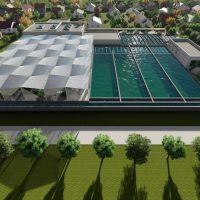Posted on April 29, 2016
What can we learn from simple drawings made by children not at all connected to the wastewater industry. Find out from our blogpost written by Ágnes Juhász from Organica, who was a judge at a recent children drawing competition.
Recently a national children’s drawing competition was held under the framework of Climate-KIC. The topic was “Energy Efficiency and Sustainability in Schools”, all imaginative, futuristic and innovative creations were welcome from children ages 6 to 14. The artworks were judged by a professional jury and one of them happened to be me. As an FYI, my role at Organica is Associate Manager.
Even though I have always been interested in psychology, I am not an expert on children’s drawings. Therefore first of all, I had to think about my own evaluation criteria; at the end I decided not to give the highest ranking to the most detailed drawings, but I was focusing on the ideas and concepts behind them. I gave more value to the drawings where I could see environmental friendly solutions and a concept which could lead to a better world. You can find here some of my favorites:
We luckily received a lot of drawings and at the end I was not just evaluating them, but also noticed a few interesting points, which might catch your attention too.
The first thing I noticed was the significant role of nature. Almost every child imagined a sustainable school to have a strong connection with nature. Most of the schools were surrounded by a park or forest, have their own garden with flowers, vegetables and fruits. Some of them even imagined trees inside the classrooms. In my opinion this has a very strong message, although more than 50% of the world’s population lives in cities, children would like to keep their connection to nature in their everyday lives.
Plants help to lower stress level, reduce blood pressure, they remove most of air toxins, and keep the humidity level matching the recommended human comfort range. Recent studies also show that being surrounded by plants at school significantly increases the scores on spelling, reading, and Math. Show me a kid who wouldn’t want to get better grades at school! On the other hand I am sure they didn’t draw plants to do better on the next Math test. We might not be aware of all good aspects of being surrounded by plants, but even children intuitively know that this is how it is supposed to be.
The other interesting point for me was about their knowledge of sustainability. A lot of drawings illustrated wind turbines, solar panels, and passive houses. These are the technologies which we frequently hear about as sustainable and environmental friendly, and it seems that the more publicity and exposure they get drives a higher acceptance rate, at least amongst children. This has a strong message for my industry: although the general knowledge on wastewater treatment is usually poor, it doesn’t mean that we can’t change it. The key is education and disseminating relevant information as broadly as possible. We need to show the world how a wastewater treatment plant can blend harmoniously into the urban environment and appear as a botanical garden. Children are open minded and if we show them this different approach, we can create a new standard, which they will carry into the future for all new generations.
The reason I was part of the jury, is because the prize of the winning class is a visit to an Organica-powered wastewater treatment plant. I am confident based on the values illustrated in the drawings that their site visit will provide a great experience for the children. Hopefully we will give them not just some inspiration for the next drawing competition, but something to remember.






